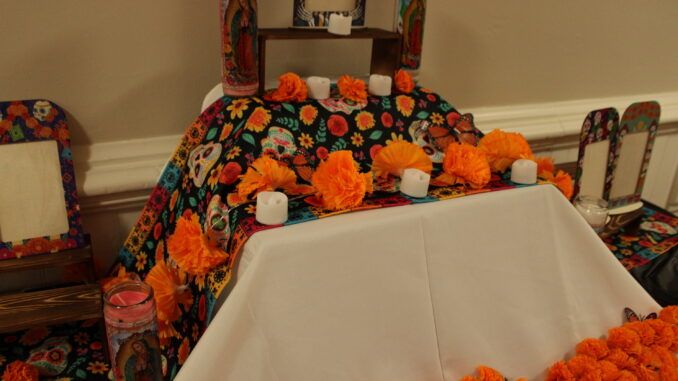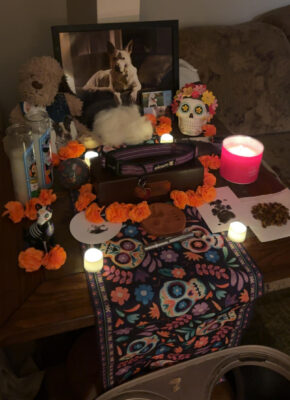
Last weekend, millions of people in countries around the world put out candles, marigolds, calaveras, papel picado, pan de muerto and more to invite the spirits of their loved ones to come celebrate Día de los Muertos with them.
According to the National Museum of the American Latino, Día de los Muertos is a holiday “to honor and commemorate the lives of the dearly departed and to welcome the return of their spirits.” It takes place on Nov. 1 and Nov. 2.
According to History.com, Día de los Muertos has roots in pre-Columbian Mesoamerica, in what is now central Mexico. While the majority of festivities and celebrations happen in Mexico, Día de los Muertos is celebrated in several countries across Central and South America, and by many Latino and Hispanic Americans.
Dallas junior River Morelli’s family celebrated Día de los Muertos when they were growing up in Mexico, but it wasn’t a “huge deal,” they said.
“It’s something that we kind of celebrate in my family, but I’ve been making an effort to kind of do more research on it and celebrate it personally,” Morelli said.
While Día de los Muertos is officially celebrated the first two days of November, Morelli said the celebrating begins before that. On Oct. 26, you light a candle and put out a bowl of water, and on Oct. 27, “lost pets come to visit us in the spirit world,” Morelli said.
They added that Nov. 1 is when “the departed souls of children come to visit,” and that typically big celebrations are held both days. Nov. 2 is when the spirits of adults are said to visit.
A typical way of celebrating Día de los Muertos is to set up an altar called an ofrenda dedicated to deceased loved ones. Ofrendas often have photographs of loved ones and are decorated with candles, marigolds, papel picado – colorful paper cut-outs – and more. Morelli added that on the altar, you might include something that belonged to the person, something that reminds you of the person or their favorite food.
“Each altar is really personal to the family,” Morelli said. “Food is also really important because we think that on their journey to come back they’re really hungry, so we typically leave out plates of food, or bread or anything that really reminds us of that person.”
The Organization for Latinx Awareness (OLA), of which Morelli is president, set up an ofrenda in the KC Stack on Wednesday. Morelli said they wanted students who celebrate Día de los Muertos “to have a space where they can put family members up there, or they can just see their culture out there.”
Griselda Iñiguez, alumna ‘19, Albion resident and former employee of the college, celebrates Día de los Muertos as well. Iñiguez was the assistant director for student success and advisor for OLA during the 2023-2024 school year. Similarly to Morelli, Iñiguez’s extended family celebrated Día de los Muertos when she was growing up, but she “never directly took part” until adulthood.
When Iñiguez was OLA’s advisor, the club set up an ofrenda in the KC Stack, just as they did this year. She said the students put the altar together, and took “submissions” from faculty, staff and other students. Iñiguez said she honored her grandfather on the altar.
“With OLA was actually the first time I participated in a community ofrenda, which was really cool,” Iñiguez said. “It just felt really cool to see my personal life connected with so many other lives.”
Día de los Muertos was “really personal” for Iñiguez this year, because her dog, Luna, passed away in June. Iñiguez had Luna since she was a baby; Luna was even her emotional support animal (ESA) when Iñiguez was a student at Albion. On Oct. 27, Iñiguez set up her ofrenda for Luna, and kept it dedicated to her dog for the remainder of the holiday. She put out kibble and a bowl of water for Luna, and would light a candle when she wanted her to visit, Iñiguez said.
“I feel very honored in different ways to have had Luna, and Día de los Muertos, as far as meaning to me, grew like 500% this year,” Iñiguez said.

Assistant Director for Spiritual Life Laura Todd said Día de los Muertos is “really meaningful and comforting to a lot of people.”
“It’s a time to remember and celebrate people that have died, often from a humorous and celebratory perspective which we often don’t do, and so it’s really important to take that time,” Todd said.
Morelli said that they started personally celebrating Día de los Muertos after their grandmother died “a couple years ago.”
“It’s something that made me feel really connected to her, and it made me feel really connected to family members that have passed,” Morelli said. “Especially being someone who doesn’t really have much family in the U.S., it really makes me feel connected to my family in Mexico.”
Iñiguez added that Día de los Muertos has “done a lot” for her this year in terms of her grief for Luna.
“I think Día de los Muertos really offers people a physical manifestation of grief; an opportunity to connect with your grief,” Iñiguez said.
If someone who isn’t Latino and didn’t grow up celebrating Día de los Muertos wants to start observing the holiday, Iñiguez said they “absolutely” can – but “there’s obviously a right way to do it and a wrong way to do it.”
Iñiguez’s advice to people who want to make their own ofrenda and start engaging in Día de los Muertos is to research it, “credit people where credit is due,” be respectful and remember the holiday isn’t just about sadness, it’s about joy.
“I love the sharing part, I love the community part and I love the celebration of life piece,” Iñiguez said.
Iñiguez added that “some people might have their own feelings” about people outside of Latino and Hispanic communities celebrating Día de los Muertos, but she supports it, because it leads people to “appreciating another culture.”
“I think people are very valid in wanting to have it remain a closed ceremony to just the culture that celebrates it, but I really think that it’s a beautiful holiday that can open people up to empathy in a certain extent,” Iñiguez said.

Leave a Reply